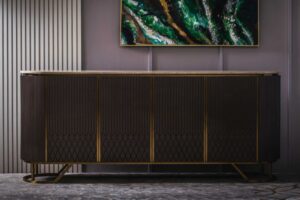Simple designs in bold colours is what works best for me, says Ankit Pahuja

Team L&M
According to a study, hardly 10 per cent of all family businesses make it into the third generation. Well, Indesign, a brand that caters to all spaces of a home from living-dining to bedroom, falls in that 10 per cent category. Ankit Pahuja, who now heads it, is the third generation of this family business. Life & More spoke with this bright young entrepreneur on his design aesthetics and vision for the company. Excerpts:
Now that you have taken over the helm of Indesign, what new things have you incorporated?
As the new head of Indesign, I have focused on building a team-oriented environment that encourages collaboration and creativity. As a result, we have implemented new technologies and design methodologies that have allowed us to improve our workflow, increase productivity and deliver exceptional client results. Additionally, we have expanded our services to offer more comprehensive design solutions, ensuring we remain competitive in an ever-changing market.
How would you describe your design style?
My design style is influenced by my philosophy of forming the following function. I believe in creating designs that are not only aesthetically pleasing but also practical and functional. I strive to create designs that are minimalistic, clean, and timeless. My designs are often characterised by their simplicity, bold use of colour, and attention to detail.
Where do you find inspiration for your designs?
I find inspiration for my designs in everyday life, nature, and surroundings. Architecture and fashion also inspire me. I believe that inspiration can come from anywhere, whether from a piece of art or a conversation with a client. I am always open to new ideas and perspectives, allowing me to create unique and meaningful designs.
Why is design an essential component of the furniture business?
Design is essential to the furniture business because it differentiates product from competitors, affects customer appeal, and ultimately drives sales. Good design can enhance the value of a product by making it more attractive, functional, and durable. In addition, efficient and elegant designs translate into efficient production processes, saving time and reducing costs. Finally, the right design provides a better user experience, ensuring customer satisfaction and repeat business.
What do you find most challenging about bedroom design?
The most challenging aspect of bedroom design is reconciling functionality with aesthetics. Balancing the need for storage, lighting, and functionality with a design that creates a harmonious and peaceful environment can be challenging. The bedroom should be a personal retreat that reflects the client’s lifestyle, preferences, and personality. It’s crucial to craft a design that is both practical and visually appealing while also taking into account the specific needs and desires of the client.
What challenges do you find in living-dining room design?
Designing a living-dining room can be challenging because it requires harmoniously blending two distinct spaces with different functions. Balancing the seating arrangements for both spaces while ensuring they are cohesive and functional is critical. Another challenge is creating a sense of flow and continuity between the two areas that blend well with the rest of the home decor. Additionally, lighting is vital, as using different light sources for each area can help add depth and ambience and define zones in the space.

Which colours are in vogue for the living-dining and bedroom interiors?
For living-dining and bedroom interiors, neutral colours such as whites, beiges, greys, and shades of green are favoured. Warm and cool hues with calming, soothing, and relaxing effects; are also in fashion. It’s a good idea to utilize neutral shades as a base and add bright colours through artwork, accessories, and décor items for interest and variation. A blend of organic materials such as natural woods, leather, and metals with textures and soft finishes such as plush rugs and blankets can create a cosy and welcoming space.
Which kind of designs are preferred by homeowners for living-dining and bedrooms?
Homeowners today are seeking designs that are simple, timeless, and neutral. For living-dining areas, a combination of functional and contemporary with a blend of textures (i.e., wood, fabric, metal) and finishes (i.e., matte, shiny) create a cosy and inviting atmosphere. For the bedroom areas, there’s a preference for designs that evoke relaxation and calmness, i.e., natural and soothing colours, stylish yet comfortable furniture, and minimal decoration with thoughtful prints and patterns. In addition, personalised designs wherein a space is customised to reflect the homeowner’s style and personality are also in demand.
What are your future plans?
I intend to keep learning and evolving, adapting to the ever-changing trends and advancements in the design world. I aspire to provide insightful, relevant and accurate information to support designers, architects, and homeowners in their quest for aesthetically pleasing, functional and sustainable spaces.
Edited by Upasana Kaura





